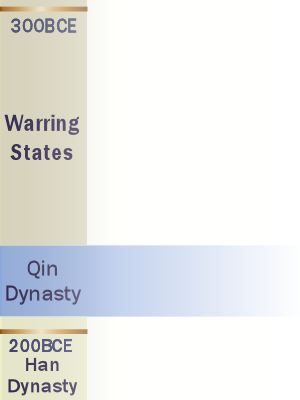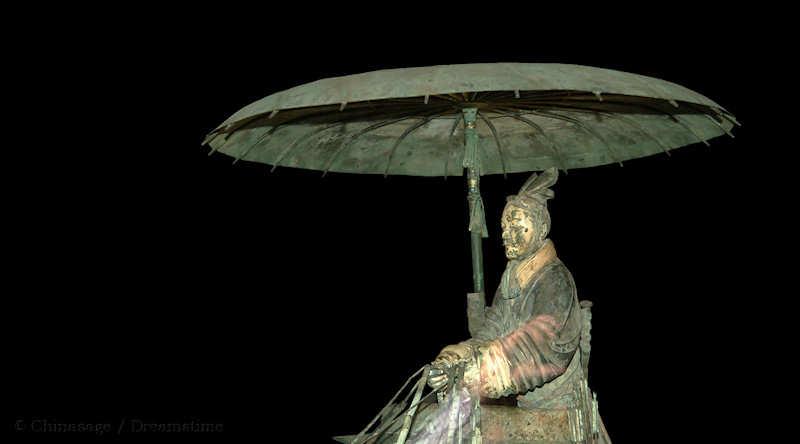Qin (Chin) Dynasty 秦朝 221 - 206 BCE

The Qin dynasty, although short-lived, is arguably the most important as it created so much of what now defines 'China'.
Before the Qin dynasty there had been seven kingdoms clustered around the Yellow and Yangzi Rivers. These kingdoms were engaged in incessant conflict during the Warring States period until one of them, the ‘Qin’, proved dominant. The Qin kingdom was on the western edge of China and so needed an efficient cavalry to repulse raids by the nomadic people on its western borders and these military skills proved decisive. The Qin were considered so close to barbarism that their representatives did not attend meetings with the other six warring states. It may also have been the first of the kingdoms to use iron weaponry giving it an advantage over those still using bronze. In addition they fought from horseback with the new preferred weapon - the crossbow - and not like the other statesfrom cumbersome, unwieldy chariots .
The kingdom may have provided the western name ‘China’ as it is now thought that it derives from ‘Qin’ (pronounced 'tchin').
Widespread reforms
Through dictatorial (Legalist) rule, the first Qin emperor defeated all the other kingdoms and formed for the first Chinese nation state under one ruler and inventing the concept of ‘Emperor of China’. Although the term 'dynasties' is used for the preceding periods it was only under the Qin that the state was centrally controlled under one person, previously it had been a case of loose association with a local ruler having autonomy. The Qin state was an efficient military machine and pursued a policy of subjugation of ‘all under heaven’. It was brought in as a fervent revolution, not just a change of leadership. By conquests as far south as Guangdong, Qin Shihuangdi created the rough boundary of present day China . The Great Wall of China was built to define China's northern limit by joining and strengthening existing border walls. Other major construction projects included his capital city, his mausoleum and a network of roads, canals and irrigation systems. Control of water supply enabled agricultural production to increase to provide food for the burgeoning empire.
As well as bringing in unified systems for weights; measures and roads he imposed a unified system of Chinese characters for writing based on the Qin script. The Qin kingdom had conquered many other kingdoms with higher populations and with their own writing scripts; to be able to administer them efficiently everything had to be standardized. The standardization of weights was important because tax was collected in goods rather than money. His transport reforms enabled the creation of a network of roads radiating from the capital near Xi'an with a standard length of axle allowing the transport of goods over long distances. (Deep ruts in the road created by carts allowed only those with a matching axle width to travel easily). The new roads had three lanes, the central one was reserved solely for Imperial use. However, this road network amounting to 4,250 miles, proved counter-productive in the end as it enabled rebels to quickly flee a pursuing army. The use of the brush for both writing and painting came into use, superseding the stylus that had been used to impress marks into clay or inscription onto stone.
Administration
Qin Shihuangdi moved the country away from a slave to a feudal system. He disbanded the many militia that had maintained the earlier state of incessant warfare. The creation of a complete set of unambiguous laws for the first time codified rights and responsibilities. The leading Legalist doctrine came from the 'Book of Lord Shang ➚' 商君书. Arbitrary punishment was abolished, punishment had to follow the strictly defined rules/laws. Hierarchical responsibility was introduced, the local leader was held personally responsible for the actions of everyone under him. A key reform of the Qin Dynasty was the division of government into three separate functions : administration; military and supervision of the administration. The later function included the appointment of officials and the keeping of records, it checked that the administration carried out the orders it had been given. This division made the empire less likely to break apart, as no one person held both the administrative and military power needed to mount a revolt. An administrator was appointed directly by the emperor from a distant area so he would have no loyal, local power-base to give support.

Second Emperor and Collapse
The Qin dynasty was effectively a one man 'dynasty' lasting only 25 years as his successor failed to keep the country united. Qin Shihuangdi's chief Minister Li Si ➚, the architect of many of the reforms, tried to cling to power by controlling the succession. The Crown Prince, who had voiced dissent over the reforms, was tricked into committing suicide by way of a forged order sent by Li Si purporting to be from his father. So it was Shihuangdi's second son, who reigned under the title ‘Er Shi’ literally ‘Second Emperor' (229 - 207 BCE) on Qin Shihuangdi's death. A weak and dissolute man, his rule lasted just three years, he gave power to his chief eunuch Zhao Gao who turned the capital into a bloodbath with chief minister Li Si amongst his many victims. The people had had enough of enforced slave labor, crippling taxation, brutal treatment and so the centralized system broke down. The reaction to the dissent was to act with even greater brutality. Zhao Gao seized power and forced Er Shi to commit suicide in 207BCE supplanting him with Er Shi's young nephew, but by then it was too late as the Qin Empire was already falling apart and the Han dynasty soon emerged.

Emperor Qin Shihuangdi 始皇帝 [246 BCE - 10 Sep 210 BCE] or Chhin Shih Huang Ti WG

The First Qin Emperor of China
Qin Shihuangdi is the first historical figure of great significance in China. Despite the distant date, many of his initiatives remain in place today. His chief achievement was the first unification of China under one man. At the age of 13 he had become king of the Qin (the western-most kingdom of the Warring States) and inherited his father's zeal for conquest.
King Zheng was a dictatorial and harsh ruler who followed the Legalist philosophy. In rough terms Legalism raised the Emperor above all others, who are deemed prone to evil, he ruled absolutely and all had to obey his commands, they had no rights other than those he gave them. He mobilized the people of Qin into forced labor for his many projects and in 11 years had swallowed up the other states of the former Zhou empire to form the 'nation' of China for the first time. To keep the peace he held hostages from the defeated royal families and melted down the bronze weapons of all the armies into huge bells and statues. By kidnapping the feudal lords and kings he broke their power and imposed direct Imperial rule. Even surrender was no guarantee of survival, more than a million opponents died in his ruthless conquests. During the Qin dynasty he re-engineered the existing walls defending individual kingdoms into one Great Wall for the united nation. He sought to wipe out history by burning any books that conflicted with his Legalist philosophy including those of Confucius. His approach was to start a new system from scratch, ignoring all that had gone before. To even mention historical events in conversation was a serious offense. However it must be said that some of these allegations made in the succeeding dynasties, with some vindictiveness, are not backed up by hard facts. When the Qin dynasty fell, the vast Imperial library was burned to the ground doing far more destruction to literature than Qin Shihuangdi ever did. The fragments of books that escaped burning proved a rich area of study for subsequent scholars who tried to piece together the originals. He standardized weights, measures, roads, and the Chinese script. The long history of the written Chinese language had created dozens of different ways of writing each character, the Emperor ordered his minister Li Si to standardize the written language. To ensure adoption of the new standard script, books written in the old scripts were burnt. The dictionary by Xu Shen 许慎 called the Shuo wen jie zi 说文解字 documents the changes to the script.
There were wide roads radiating out in all directions from Qin Shihuangdi's huge new capital at Xianyang, Shaanxi. At times 15% of the population was conscripted into his great construction projects: the Great Wall; the capital Xianyang and his Imperial tomb.
The imperial name Qin Shihuangdi means the first august emperor of the Qin. The use of the character for august deliberately echoes the similarly sounding 黄 huáng which links him to the legendary founding Yellow Emperor.
Qin Shihuangdi was hard working with an eye for detail. He was paranoid about possible assassination plots. His workload was measured in weight of books (at that time not on paper but on bamboo strips) he could process in a day. The cruelty, forced labor, high taxes and upheavals eroded public support and on his death the dynasty quickly fell apart. However, many of his wiser reforms were retained by the succeeding Han and later dynasties. The idea of a unified country of China has persisted from his day to the present time.
The ambivalent view of Qin Shihuangdi as brutal tyrant or unifier is brought home in the epic film ‘Hero ➚’ by Yimou Zhang.
Terracotta army and tomb
One of the main public works constructed by Qin Shihuangdi was his own tomb. Plans began when he was just 13 years old. The building began in earnest on his accession in 221BCE. Later in life he became obsessed with seeking immortality and the after-life, building the famous Terracotta Army to guard his tomb. Over 600,000 people worked on the tomb that covers over 39 sq miles [100 sq kms]. The tomb is in the form of a large artificial hill but partly due to reverence to the dead in China has lain undisturbed for 2,000 years. The tomb area is carefully sealed so that groundwater cannot enter it. It was only in 1974 that a farmer accidentally broke into one chamber containing some of the famous Terracotta Army with over 8,000 soldiers so far discovered. As well as full scale soldiers half-size bronze chariots have also been found - made up of as many as 3,000 individually cast pieces. Another pit has the skeletons of rare animals with ceramic attendants and another entertainers (jugglers, acrobats). Around 1,000 craftsmen worked on making the army using standard molds for the torso and legs but each given individuality in the face and clothing. Each held some sort of weapon. Only a tiny fragment of the tomb complex has so far been excavated and there are no plans for a large scale excavation of the site. It is thought that at its center is a map of China with rivers and lakes of mercury (due to the discovery of traces of mercury in the soil) beneath a vaulted ceiling covered in pearls for stars. With the Emperor it is believed 48 of his concubines were buried alive in separate small tombs to entertain him in the afterlife. Like the Egyptian pyramids the builders shared the same fate as the concubines in case they might reveal secrets of the tomb's construction and contents.